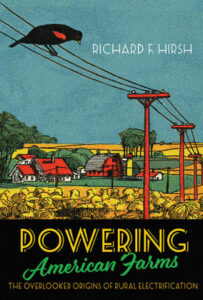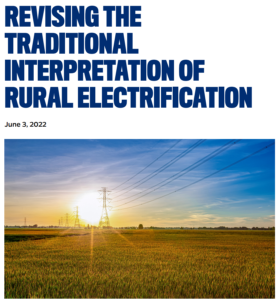 Richard Hirsh’s new book on the rural electrification, Powering American Farms, challenges the notion that electric utilities neglected rural customers in the years before government intervention. Drawing on previously unexamined resources, Hirsh demonstrates that power firms quadrupled the number of farms obtaining electricity in the years between 1923 and 1933, for example. Though not all corporate managers thought much of the farm business, a cadre of rural electrification advocates established the knowledge base and social infrastructure upon which New Deal organizations later capitalized. The book also suggests that the conventional storyline of rural electrification remains popular because it contains a colorful hero, President Franklin D. Roosevelt, and villainous utility magnates, such as Samuel Insull, who make for an engaging—but distorted—narrative. Read more about the book here.
Richard Hirsh’s new book on the rural electrification, Powering American Farms, challenges the notion that electric utilities neglected rural customers in the years before government intervention. Drawing on previously unexamined resources, Hirsh demonstrates that power firms quadrupled the number of farms obtaining electricity in the years between 1923 and 1933, for example. Though not all corporate managers thought much of the farm business, a cadre of rural electrification advocates established the knowledge base and social infrastructure upon which New Deal organizations later capitalized. The book also suggests that the conventional storyline of rural electrification remains popular because it contains a colorful hero, President Franklin D. Roosevelt, and villainous utility magnates, such as Samuel Insull, who make for an engaging—but distorted—narrative. Read more about the book here.

Even after decades of retelling, the story of rural electrification in the United States remains dramatic. As textbooks and popular histories inform us, farmers obtained electric service only because a compassionate federal government established the Rural Electrification Administration (REA) in 1935, during the Great Depression. The agency ’s success in raising standards of living for millions of Americans, such that more than 80 percent of farms received electric power in 1950, contrasted with the failure of big-city utility companies, which served under 12 percent of farms just 15 years earlier. Traditional accounts, written by influential historians of the New Deal era, argued that greedy corporate managers showed little interest in the apparently unprofitable farmers, who endured unbearable hardships that easily could have been mitigated if only they had access to electricity.
Though emotionally stirring and widely accepted, this story of rural electrification is wrong–or, to say the least, severely exaggerated–a situation that my new book, Powering American Farms, seeks to redress. It reinterprets the history of rural electrification by demonstrating that private (investor-owned) utility companies actually did much to promote electrification in the dozen years before creation of the REA. Read more…

Rural electrification in the United States (and most industrialized countries) is now a historical fact. But it remains an important goal in several developing countries, where (in 2019) about 13 percent of the world’s population–940 million mostly rural inhabitants–do not have access to electric power. For many years, the World Bank and other international aid agencies provided resources to build massive generating plants such as hydroelectric dams. Moreover, they offered support to construct central stations and distribution systems in cities and surrounding regions–similar to the networks that evolved in the United States.
But perhaps policymakers should pay more attention to the early history of American rural electrification, in which many farmers took advantage of isolated generation technologies, such as wind-turbine dynamos, internal-combustion-operated generators, and batteries. While farmers using such systems may not have enjoyed the maintenance-free operation that could be attained by having wires extended from central power stations, they nevertheless obtained several productivity- and life-enhancing benefits that electricity offered. Taking advantage of today’s small-scale and renewable-energy generators, rural electrification advocates in developing nations could gain greater success by pursuing a course of action that Americans abandoned in the 1930s.
Read more…